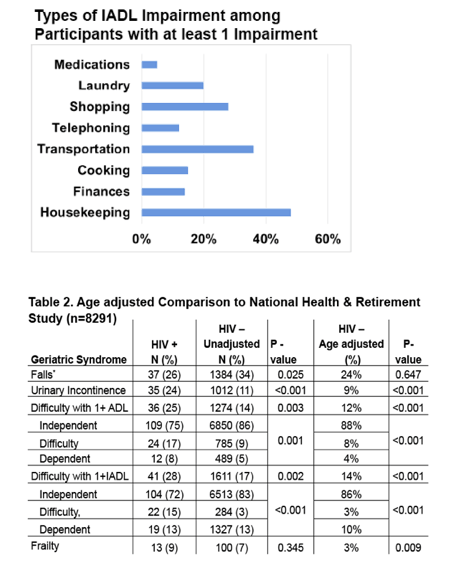 |
 |
 |
| |
Less Physical Activity, Less Education Tied to Daily Living Impairments [Disabilities] in Older HIV Group - ACTG5322
|
| |
| |
from Jules: In the 5322 presentation at CROI 2016 - [1] NNRTI use was associated with frailty (Odds Ratio: 1.53) - [2] for those HIV+ >60 21% are frail & 17% pre-frail; in the 50-59 age group 60% are frail & 44% pre-frail & 36% were not frail......http://www.natap.org/2016/CROI/croi_59.htm
HIGH Rates of Impaired Daily Functioning: "at avg age 57, 4 comorbidities; difficulty with instrumental activities of daily living (46%)....http://www.natap.org/2015/HIV/052015_04.htm
-------------------------
7th International Workshop on HIV and Aging, September 26-27, Washington, DC
Mark Mascolini
Low physical activity, less education, and neurocognitive problems raised the odds of impaired instrumental activities of daily living (IADL) in a 1000-person analysis of older AIDS Clinical Trials Group (ACTG) participants [1]. Private versus public insurance more than halved chances of impaired IADL, but HIV-related variables had little impact.
ACTG protocol A5322 monitors HIV-positive adults at least 40 years old who began antiretroviral therapy in an ACTG trial. When participants entered A5322, researchers evaluated them for 8 IADL categories--housekeeping, money management, cooking, transportation, telephone use, shopping, laundry, and medication management. They defined IADL impairment as needing assistance in one or more of these categories.
Frailty assessments included five variables--4-meter walk, grip strength, self-reported weight loss of 10 pounds or more in the last year, self-reported exhaustion, and self-reported low physical activity. The ACTG team considered people who met 3 or more criteria frail, those who met 1 or 2 criteria prefrail, and those who met no criteria nonfrail. The investigators measured neuroimpairment by the ACTG Neuroscreen, which includes Trailmaking A and B and the Digit Symbol test. Neurocognitive impairment meant 1 or greater standard deviation (SD) below 0 on 2 or more normalized scores or 2 or more SD below 0 on 1 or more scores.
The study involved 1015 people with a median age of 51 (interquartile range [IQR] 46 to 56), 19% of them women, 29% black, and 20% Hispanic. People 60 or older made up 15% of the study group. Half of participants (51%) had a CD4 nadir below 200, and median CD4 count at A5322 entry stood at 616 (IQR 449 to 822). A large majority of participants, 94%, had a viral load below 200 copies, and the group had taken antiretrovirals for a median of 7.8 years (IQR 4.4 to 12.0). One third of participants relied on Medicare or Medicaid, and 41% had private insurance.
While 17% of participants had 1 IADL impairment, 6% had 2 or more. Impairments usually involved housekeeping, transportation, shopping, and laundry. IADL disability rates in this group were 2 to 3 times higher than in the general-population NHANES group. Among 999 participants evaluated for frailty, those who met frailty criteria were more likely to have 1 or more IADL impairment (52%) than were people with prefrailty (21%) or nonfrail people (11%).
A multivariable model identified four independent predictors of impaired IADL at the following odds ratios (OR) (and 95% confidence intervals):
Raised odds of impairment:
-- Neurocognitive impairment: OR 2.28 (1.4 to 3.71), P < 0.001
-- High school education or less versus more: OR 2.22 (1.43 to 3.47), P < 0.001
-- Under 3 days of physical activity per week: OR 1.97 (1.3 to 2.98), P = 0.001
Lowered odds of impairment:
-- Private insurance versus Medicare or Medicaid: OR 0.42 (0.25 to 0.7)¸ P < 0.001
A history of cardiovascular disease almost doubled the odds of impaired IADL in an association that fell short of statistical significance (OR 1.91, 95% confidence interval 0.94 to 3.86, P = 0.07). No HIV-related factors predicted IADL impairment.
The ACTG team concluded that IADL disability in older adults with HIV is linked to neurocognitive impairment and socioeconomic or lifestyle factors but not to traditional comorbidities or HIV-related factors. They proposed that modifiable risk factors such as smoking and low physical activity "may be targets for interventions to reduce IADL impairment."
Reference
1. Erlandson KM, Wu K, Kalayjian R, et al. Factors associated with limitations in daily activity among older HIV+ adults. 7th International Workshop on HIV and Aging, September 26-27, Washington, DC. Abstract 3.

|
| |
|
 |
 |
|
|